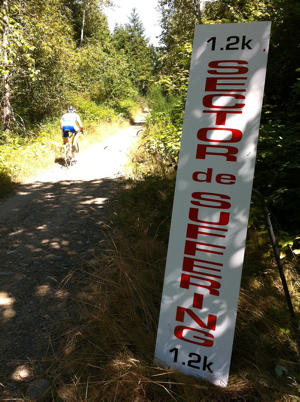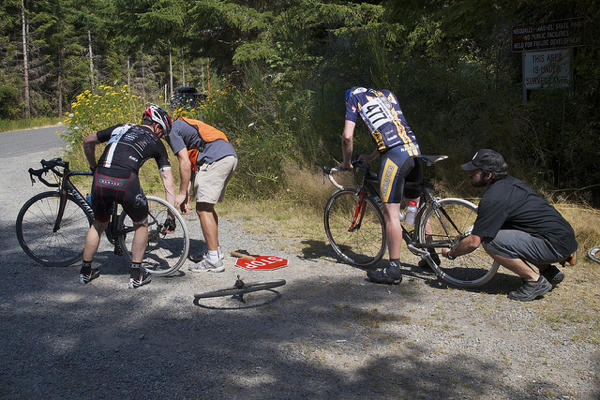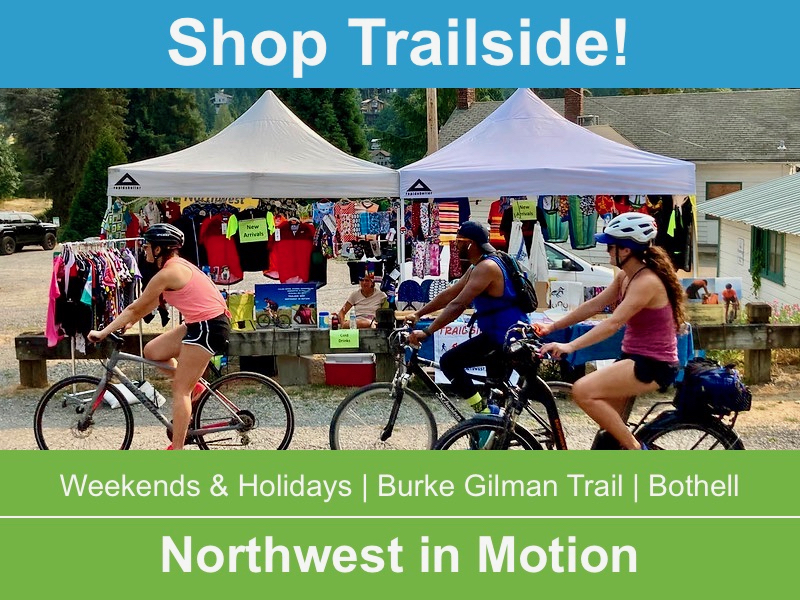Kermesse (also kermese or kermis) racing is a staple in Belgium, and starting to gain a foothold here in the Pacific Northwest. In Belgium kermesse races happen almost daily as part of the summer festival season. Here in the Northwest, kermesse races are often described as a cyclocross-road race hybrid, but that’s not quite right: Kermesses are a circuit race (in which the course is a loop longer than that of a criterium, but shorter than that of most road races), with a mix of paved and dirt sections.
Road race season around here typically starts with time trials in the February/March timeframe, transitions to road races in late winter and spring, and then to criterium races during the summer. Starting this year, two kermesse races offer an alternative to the early season time trial ritual:
Feb 5: Andy Salmon Kermesse–Register
Named after Andy Salmon who is…either:
1. A close personal friend and confidant of kermesse race organizer Michael Pruitt (aka PruDog) or
2. Andy Salmon isn’t actually a real person, but rather the misspelling of racer Randy Salamon’s name on a results sheet that has since become a meme among organizers.
Feb 19: Mashel Nisqually Kermesse–Register

Michael Pruitt has been the force making these races happen and explained the history behind them:
“I’ve always been fascinated with the Belgian semi-classics, especially Het Volk. These races feature lots of cobbles and usually horrible weather. The winner almost always seems shattered at the finish but so do 2nd, 3rd, 4th…… I just love how riders have to earn a finish. We don’t have any cobbled races here but we did have a similar race I loved – the Spokane River Roubaix. The first year I did it I made the break only to get knocked off my bike and into a ditch by farm machinery passing us on the road. Now, a normal person would think ‘This is insane and I am never coming to this again.’ I thought: ‘This is awesome!’ and managed to get 16th. That ended up being the final year for the race and I kept hoping it would come back. Finally I decided to do something about it and put on 5 races back in 2004 starting with the Ohop Trophy. We scaled back the next year and did the 2nd Ronde Ohop in February.”
Tell us about the progression of kermesse racing in the Pacific Northwest:
“It’s been a slow development. The first race, Ohop Trophy, was really successful in part because a bunch of guys from the Gentle Lovers race team (Portlandia, OR) came up. They loved it and I thought I had hit gold on the very first try. Was I disappointed when the next round only had half the turnout because the OR guys decided to put their on own Kermesse series. But, you know, a unique regional type of race was born. Since then they’ve (Oregon kermesse organizers) done their own thing with it and so have I. The Oregon races tend to be more of a dirt-criterium course where ours tend to be more of a short road race with dirt sections.
Both kinds of races came out of that original Ohop Trophy race back in 2004 and I think the philosophy for both is based in the core assertion that a NW kermesse is a circuit race that can be won on a road or a cyclocross bike. But we’ve developed independently. And I’ve taken some of their ideas too. I moved the Ronde Ohop from February to August to make it more accessible.”
How do the ronde & kermesses fit with the rest of the cycling season?
“That’s a good question. To be honest, we are still figuring out how kermesse racing fits in. There’s a balance there…ultimately I created the Ohop Trophy because it’s a race I wanted to do and no one else offered. I love the spring semi-classics with their crappy weather and all that. I’m also a roadie so that influences my perspective. But, I also want kermesse racing to be an attractive option to other promoters. So we are adapting to what we are learning. My hope is that we see kermesse racing grow to be a viable event from January through September, with the shorter pure kermesses serving as a transition from cross to road in January to February and the longer Ronde-style kermesse transitioning road to cross in August-September. That probably didn’t answer the question but NW-style kermesse racing is still in its infancy. The reality is that many riders still don’t understand what it is – they don’t have the context to understand it. So right now August-September is hot for kermesse racing because we don’t have to deal with weather – just getting people to understand what a kermesse is and how it is and isn’t like cross and road. Once enough people do it and understand it then I hope we’ll see it viable in January-February too.”

What is the long-term vision for kermesse racing in the PNW?
“The number one goal is to make kermesse racing popular enough that we can have all the petty, internecine squabbles organizers of cross and road have. I mean, right now, it’s just me and the OR guys and it’s not really very ripe for TMZ. On the one hand, I jest. On the other hand, well I am serious. I want this niche to grow to the point that organizers can complain that other organizers just don’t get kermesse racing. At that point we’ve made it. I never used to get emails complaining about the categories we offer but I do now and that’s awesome. Please don’t send me these emails, but it means it’s on people’s radar.
I’d also like to see kermesse racing get to a point where it’s is recognized as its own type of racing like criteriums or cyclocross. And even longer-term we’d like to establish kermesse races as a major part of the land-use plans of state parks so that it’s expected we will use them rather than being a nuisance.”
Reports from riders who competed in the early days of the Ronde Ohop frequently used descriptors like “epic,” which tends to attract only a limited subset of the racing population. But, as awareness has grown the kermesse races are now becoming recognized as a fun, challenging alternative to standard road races, and the numbers of participants is growing.
As Ross Gilbert put it: “These races are totally different than any race I have done. They have something for everyone and there is never a dull moment.”
Lee Smith, a woman who has competed in several Ronde Ohops describes why she keeps coming back for more:
“The Ronde Ohop is in a very pretty, quiet area. It starts with two loops of nice, barely trafficked highway, where the race is like a real road race. Then the fun begins, with multiple loops of the dirt + park pavement section, where everything spreads out and it becomes more like an off-road race. Everything is low-key, and everyone has fun. There is nothing at all sketchy about the dirt sections, and I have never heard of anyone crashing in this race. At worst, there are some flat tires. I would encourage any women who are looking to have fun, and to try something different, to turn out for the Ronde Ohop!”

The course:
The dirt sections in all of the kermesse races are in the Mashel-Nisqually Park; park management has been great to work with and has welcomed the race organizers to use the park. The basic course gets reconfigured depending on the race, with specific sectors. The main sectors are Détente-a relatively easy section, the Sector of Suffering-a 1.2 km moderate section, and the infamous Mur de Mashel which is a very challenging 200m climb. The Andy Salmon is a 3.7-mile loop with 1 mile of paved road; riders descend the Mur Mashel in the Andy Salmon.
Tips:
Kermesse races are challenging but not technical. Riders use road or cyclocross bikes and are advised to run 25c or 28c road tires at 80-90 psi.
Randy Salamon has this bike handling advice:
“Ride soft. Let the bike float over the pave’. Sit back, hands on the tops arms loose, KEEP PEDALING!!!!, and keep your freaking head up! You have to pay attention or your race will go sideways real quick. Other than that, I would say 25-28c tires with 80-90psi, eat your Wheaties and be ready for some fun.”
Michael Pruitt’s recommendations for a successful kermesse:
“These courses are definitely hard, but not in the way most people think of bike races. I would say they have more in common with marathons – everyone starts together but eventually the race breaks into small groups. This intimidates a lot of people. In fact, this is what makes it accessible. Unlike a traditional bike race, you don’t need to be as fast as the main field. You will find a group with similar ability. Unlike a ‘cross race you aren’t on your own either; it definitely pays to ride together. It’s a type of race that seems intimidating, but is actually more accessible for the average rider than either ‘cross or road. There just isn’t the history yet for riders to have a framework of understanding.”
Read more about kermesse racing:
PruDogBlog
Bike Hugger
